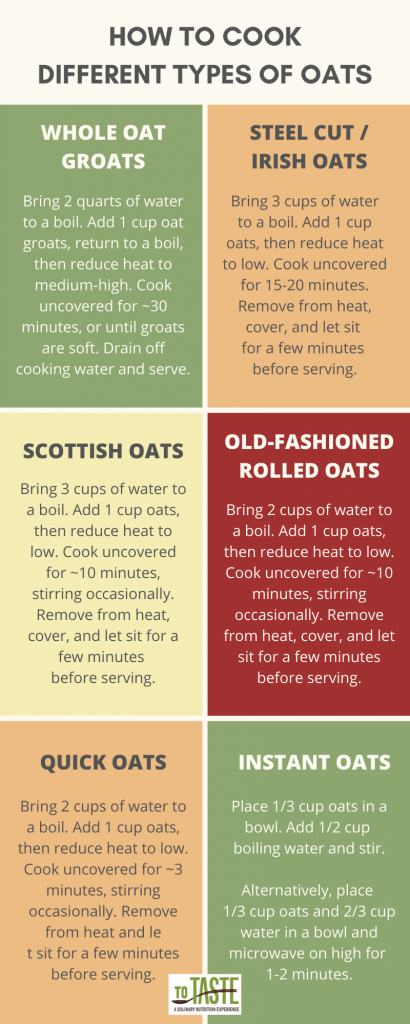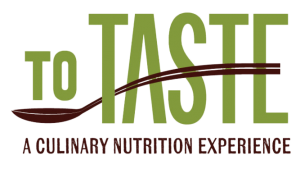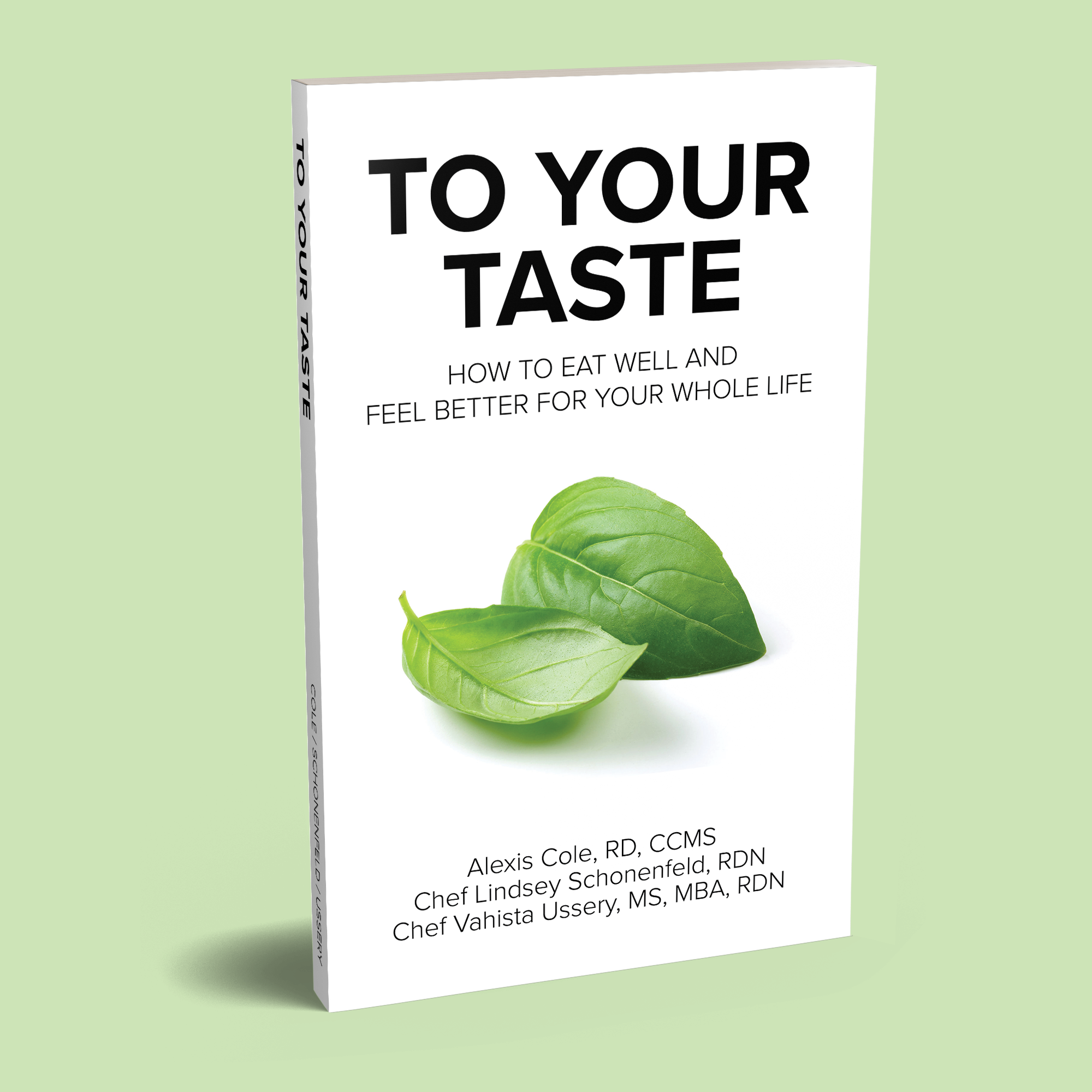If you couldn’t tell already, we love oats at To Taste. Can you blame us? They’re nutrient-rich, easy to make, convenient to store, incredibly versatile, and most importantly – delicious! In fact, many of the recipes in our Whole Life Meal Plan use them! If you’re new to the world of oats, deciding which kind to use and buy can be a bit confusing. That’s why we’ve written this article – to walk you through all of the different types of oats, what makes them unique, when to use them, and how to cook them. Read to the end for RD-approved oat recipes!
Health Benefits of Oats
Before we discuss all of the different types of oats, let’s first review why consuming oats is beneficial for health.
Oats are a whole grain and contain many essential nutrients, including complex carbohydrates with insoluble, soluble, and prebiotic fibers, vitamins, minerals, and plant-based protein.
Prebiotic fiber is important for gut health, as discussed in our article about prebiotic and probiotic foods. Soluble fiber is important for lowering cholesterol, and therefore, may improve heart health. Soluble fiber also extends satiety, maintains steady blood sugar levels, and promotes good bowel function. (1, 2, 3, 4) The vitamins, minerals, and antioxidants in oats support healthy bones, metabolism, immune function, heart health, decreased inflammation, and brain health. (5)
What are the different types of oats?
There are 8 main forms of oats:
- Whole Oat Groats
- Steel Cut / Irish Oats
- Scottish Oats
- Rolled / Old-Fashioned Oats
- Quick Oats
- Instant Oats
- Oat Bran
- Oat Flour
Which type of oats is best? That totally depends! Time, flavor, and texture vary significantly between each type of oat, so choose the form that works best for you. Aside from oat bran and highly processed versions of instant oats, they are all nutritionally comparable.
Whole Oat Groats
This is the oat grain in its most whole, intact form. The hull has been removed, but other than that, the bran, endosperm, and germ are all still intact. Of all the different forms of oats, this one takes the longest to cook – anywhere from 30-45 minutes. Oat groats can be cooked on the stovetop, in a slow cooker, or in an Instant Pot. The texture of oat groats is similar to rice or barley and is great in savory applications, such as oat risotto or a grain-based salad. For maximal flavor, toast the grains before adding the liquid. This imparts a nutty flavor which can improve the palatability of a dish.
Steel Cut Oats / Irish Oats
Steel cut oats are exactly as the name implies: steel cut. They are produced by chopping the whole oat groat into 2-4 pieces with a steel blade. This gives them a bit of a chewier texture than the whole oat groat. Steel cut oats usually take between 20-30 minutes to cook, and can be made on the stovetop, in a slow cooker, or in an Instant Pot. We recommend against cooking steel cut oats in the microwave, using them for overnight oats, or making them into granola. You may also toast steel cut oats before cooking for a more complex flavor.
Scottish Oats
Scottish oats are less common than steel cut oats here in the States, but they are no less delicious! They are made by stone grinding the whole oat groat, which makes them the best oats for porridge. They cook in about 10 minutes on the stovetop, but they can also be made in the microwave.
Rolled Oats / Old-Fashioned Oats
This is one of the most popular forms of oats, as it is incredibly versatile. Rolled oats are made by steaming the oat groat, then rolling it flat between steel rollers. Different manufacturers may create different thicknesses of rolled oats, but regardless, they are all the same nutritionally and tastewise. Thicker oats will have a chewier texture.
Rolled oats can be used in various applications, including stovetop oatmeal, overnight oats, pancakes, baked goods, muesli, granola, granola bars, energy bites, or even smoothies. Rolled oats are best cooked on the stovetop, and typically take 5-10 minutes to cook.
Quick Oats
Quick oats are a variation of rolled oats. They are also steamed, but they are often rolled thinner, and sometimes chopped into smaller pieces, giving them a larger surface area, and therefore a shorter cooking time. Quick oats cook in 1-3 minutes in the microwave and are great for quick breakfasts, as well as baked goods, overnight oats, smoothies, granola, energy bites, and pancakes. Quick oats usually have a mushier texture, so keep this in mind when choosing the type of oat for your cooking application.
Instant Oats
Instant oats are the most processed version of rolled oats. After steaming and rolling, they are often pre-cooked, dried, and chopped into smaller pieces. Instant oats cook the quickest and only need a soak in hot water or a quick zap in the microwave to be ready for consumption. Instant oats are often found in ultra-processed foods, so they are sometimes packaged with unnecessary additives and sugars. When purchasing instant oats, look for nutrition labels that only contain one ingredient: oats. Instant oats will have a mushier texture than old-fashioned oats.
Oat Bran
Oat bran is a byproduct of oat manufacturing. It is the outer layer of the oat groat, so technically, it’s not a whole grain, but it is still nutritious due to its high fiber content. It can be used as an addition to cereal, as a hot porridge on its own, or in baked goods as a way to increase fiber. Although oat bran provides a great nutritional boost, be wary of the amount you add; too much oat bran can significantly affect the texture of your end product.
Oat Flour
Oat flour is simply finely-ground rolled oats. This means that if you have a food processor on hand, you can make your own oat flour! It is oftentimes used in baked goods and can be used to thicken products, although it is not quite as effective as corn starch, potato starch, or wheat flour. Fun fact: baby oat cereal is also finely-ground oats, which means that you can make your own at home!

Are Oats Expensive?
Not at all! In facts, oats are one of the most economical ingredients that you can purchase. With the high nutrient-density of this versatile ingredient, you get loads of nutritional bang for your buck. Organic, certified gluten-free, locally produced, and name brand oats may be more expensive, so select a product that works best for your budget, values, and lifestyle. We are big fans of Bob’s Red Mill and King Arthur oats.
Helpful Kitchen Tools for Cooking Oats
Having the appropriate equipment on hand can help you make oats any time and in any way. Here are a few kitchen tools that you can use to make cooking oats a snap!
- Instant Pot: for oat groats or steel cut oats
- Slow Cooker: for oat groats or steel cut oats
- Small Pot: for steel cut, rolled, or quick oats
- Glass Jars: for making overnight oats
- Pop Top Containers: for storing dry oats
- Muffin Pan: for making baked oat cups
- Baking Sheet: for making homemade granola
- Vitamix: for making the creamiest smoothies with oats
- Food Processor: for making your own oat flour

Different Types of Oats Recipes
Here are some of our favorite oat recipes that we think you’ll enjoy. Again, we use several of these recipes in our simple and delicious Whole Life Meal Plan. Check out our Healthy Oatmeal Breakfast Recipes and Healthy Homemade Cereal articles for even more ideas from the To Taste dietitians and our dietitian friends! And while you are at it, purchase our book!
Oat Groats, Steel Cut Oats, and Scottish Oats
- Instant Pot Baked Apple Cinnamon Steel Cut Oats – Diane Norwood, MS, RDN, CDCES
- Summer Vegetarian Chili – Sharon Palmer, MSFS, RD
- Banana Peach Steel Cut Baked Oatmeal – Sarah Schlichter, RD
Rolled, Quick, and Instant Oats Recipes
- Overnight Oats Base Recipe
- Energy Bites Base Recipe
- Baked Oatmeal Cups Base Recipe
- Stovetop Oatmeal Base Recipe
- Homemade Granola Base Recipe
- Stovetop Granola Base Recipe
- Apple Cinnamon Granola Clusters
- Strawberry Kefir Smoothie with Oats
- No Bake Protein Energy Balls with Chickpeas – Theresa Gentile, MS, RDN
- Muesli with Dates – Meg Salvia, RD
- Whole Grain Peanut Butter Chocolate Energy Bars – Sarah Pflugradt, MS, RD
- Vegan Savory Oats – Erin Cooper, RD
- Mixed Berry Oatmeal Cookie Crisp – Chef Julie Andrews, MS, RDN, CD
- Apple Cinnamon Oatmeal No-Bake Cookies – Alena Kharlamanko, MS, RD
Oat Bran and Oat Flour Recipes
- Heart Healthy Brownie Batter Dip – Laura Yautz, RDN
- No Added Sugar Fruit and Nut Bread – Elizabeth Ward, MS, RD
- Easy Gluten-Free Peach Muffins – Shanon A. Garcia, MDS, RD, LD
- Two Bite Protein Brownies – Jessica Penner, RD
- Nordic-Style Oat Waffles – Maria Adams, MS, MPH, RDN
- Blender Oat Flour Pancakes – Colleen Christensen, RD
- One Bowl Honey Oat Flour Bread – Kelli Shallal, MPH, RD
- Orange, Dark Chocolate, and Sweet Potato Muffins – Genevieve Masson, MSc, RD, CSSD
We love that oats are adaptable to any taste preference, most dietary restrictions, and many budget constraints. What’s your favorite way to cook and eat different types of oats? Let us know in the comments section below!
To YOUR Taste!
Lexi











This Post Has 11 Comments
Thanks for the article Lexi! I’ve always wondered what the different oats were every time I go to the store.
Thank You for sharing your information with us. I will save this for future use. I missed not getting more information on taste and texture because I was looking for the best type to use for oatmeal cookies. Knowing they have different cooking times and their absorbancy and tenderness after baking could vary, I have been wanting to know which would be best to use.
Great question! We recommend using old-fashioned or quick oats as the best “multi-purpose oat” for baking cookies, muffins, etc. Hope this helps!
Wondering where large flake oats fit in?
Large flake oats are the same as old-fashioned or rolled oats 🙂 I think a term used more often outside the US??
I wonder as well like I mean where were they grown in the world?
Do you mean where are oats grown? A quick search shows oats prefer a cold climate. In the US, they are grown in our colder states, including North and South Dakota, Minnesota, Wisconsin, and Pennsylvania. Outside of the US, they grow in Canada, Australia, China, Brazil, Russia, Poland, Finland, Spain, and the United Kingdom.
You got me curious, so I also researched where Quaker oats are grown, and found they get oats from Canada, Iowa, and the united Kingdom. Their oats facility is in Cedar Rapids, Iowa.
Which oats are good for reducing triglyceride content
Oats are known to help reduce LDL cholesterol, but not triglycerides specifically. All of them (except packaged instant oats that contain added sugars) can help lower LDL cholesterol. Be sure to pair oats with healthy sources of fats and proteins in your meals (such as soy milk and almond butter) to balance blood sugar and promote satiety.
I really think this article also needs to discuss the glycemic index of oats, rather than suggesting all is wonderful with all kinds of oats that don’t contain added sugar.
The glycemic index of steel cut oats (depending on your source) is somewhere between 42 and 53. But quick oats have a glycemic index of a whopping 83. That’s worse than white bread! Sure they have more nutrients, but generally speaking, it would probably be good advice to stay away from them.
Thanks for your comment! Glycemic index (and more importantly, glycemic load), is a highly variable number that is totally dependent on the person, their metabolism, and the foods which they consume alongside carbohydrate-containing foods. If this is something of interest or concern to you, we recommend working with a registered dietitian or certified diabetes educator to determine how certain foods, such as oats, impact your blood sugar.